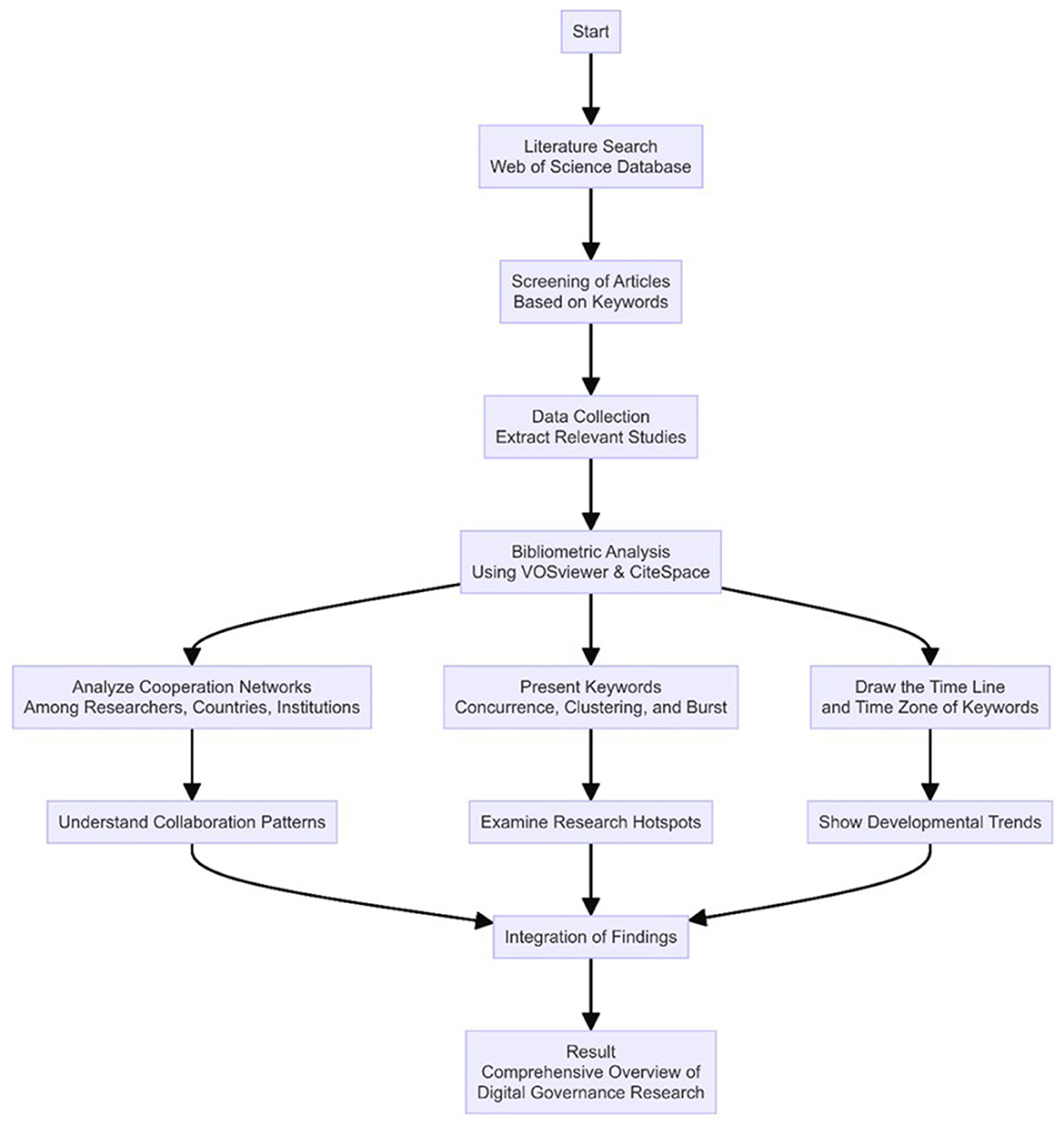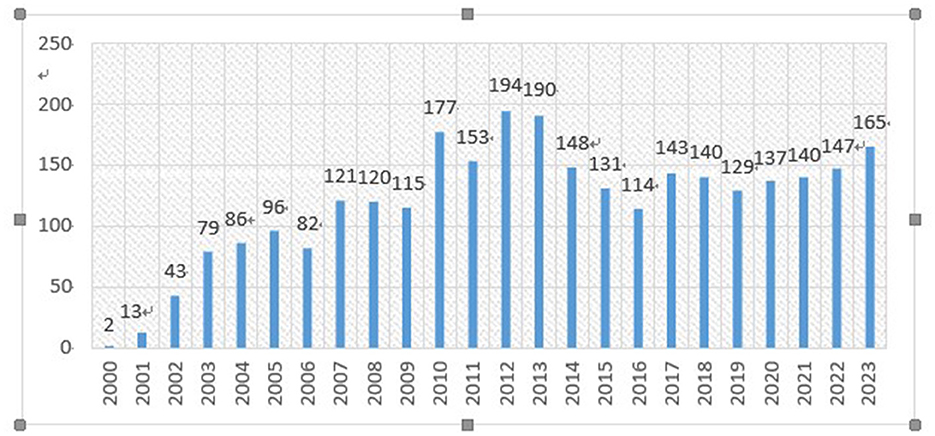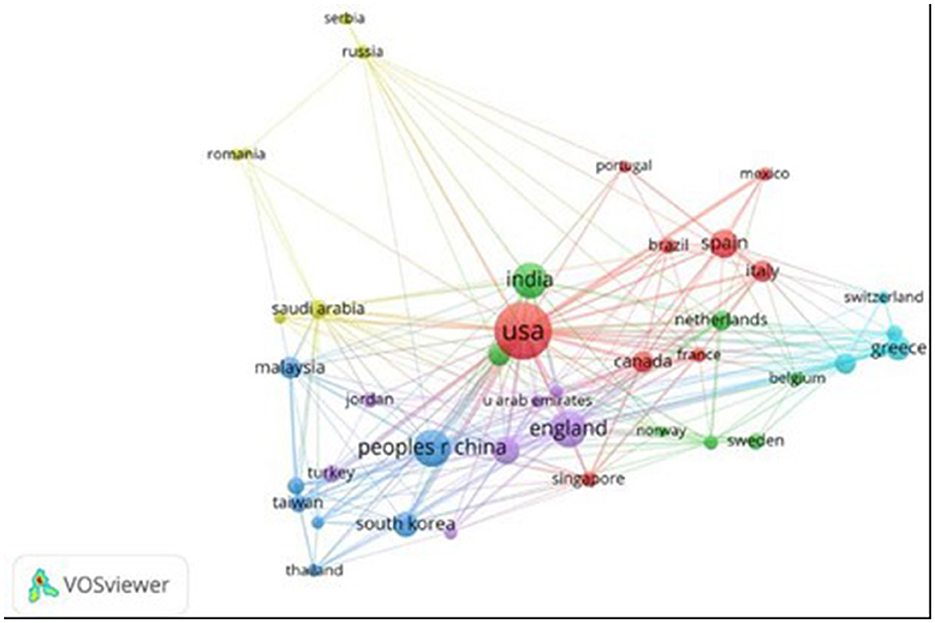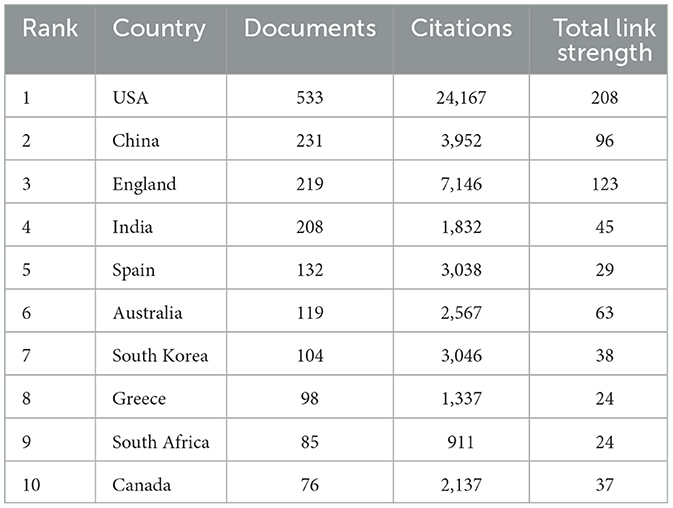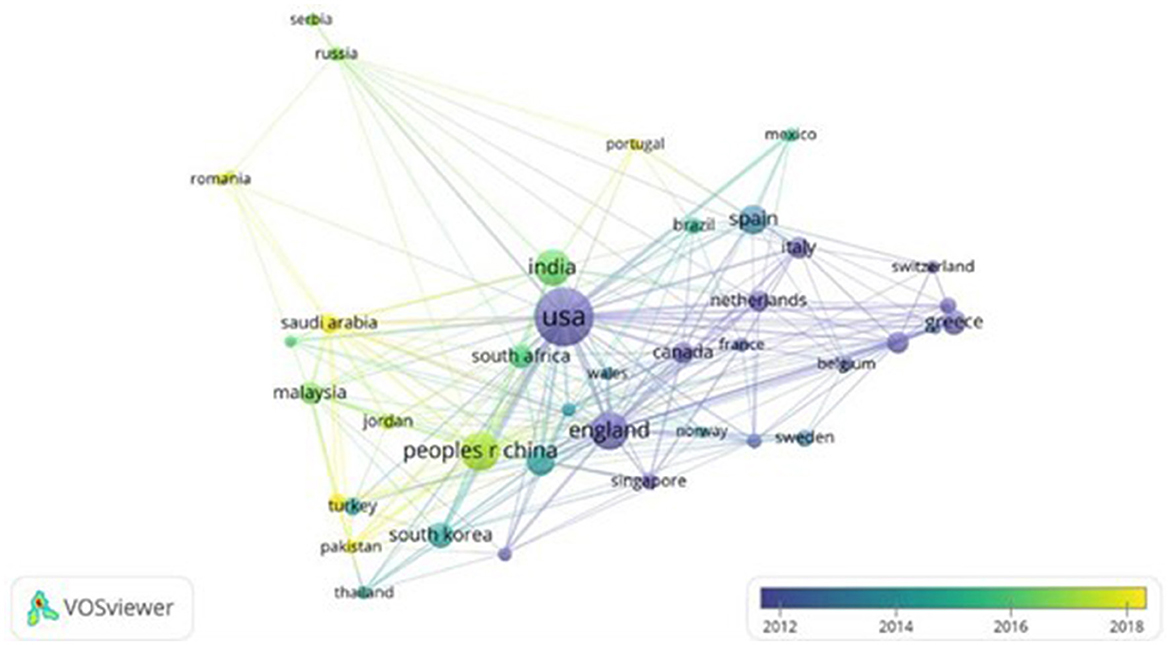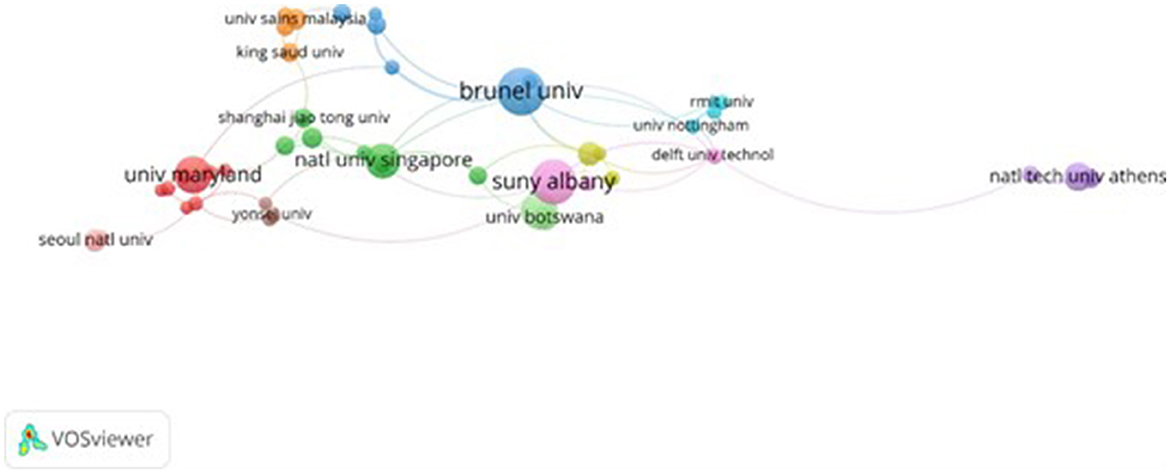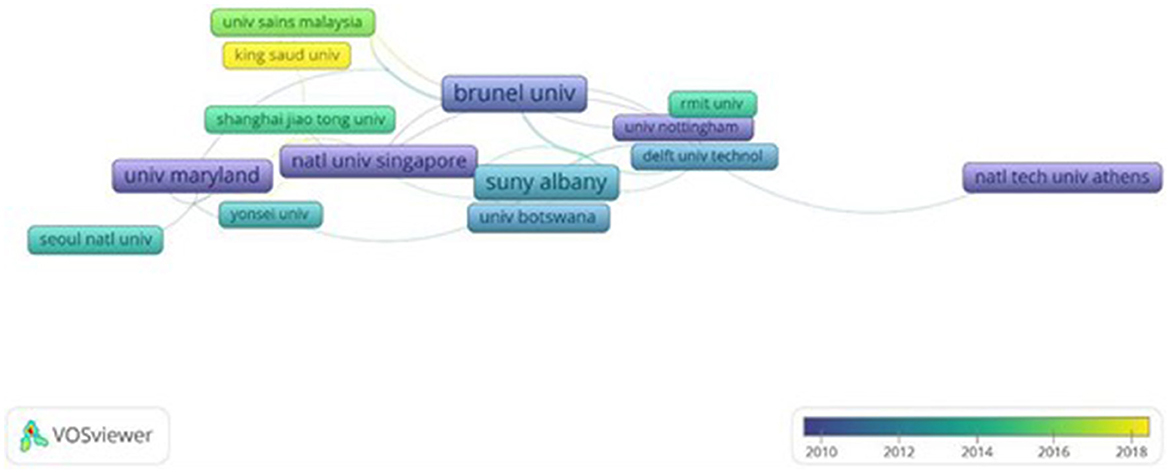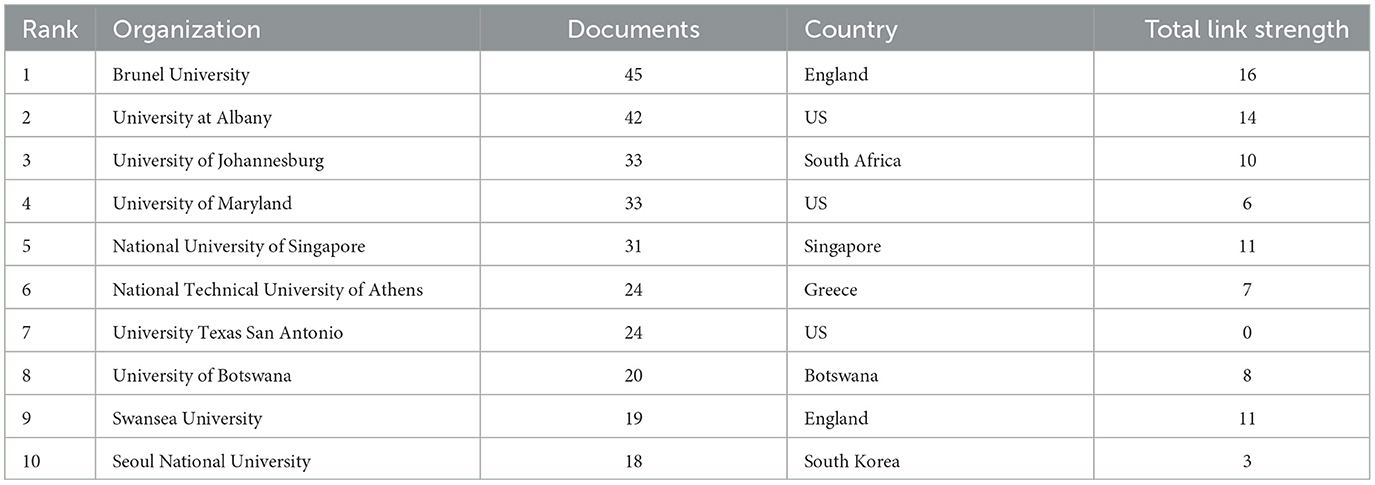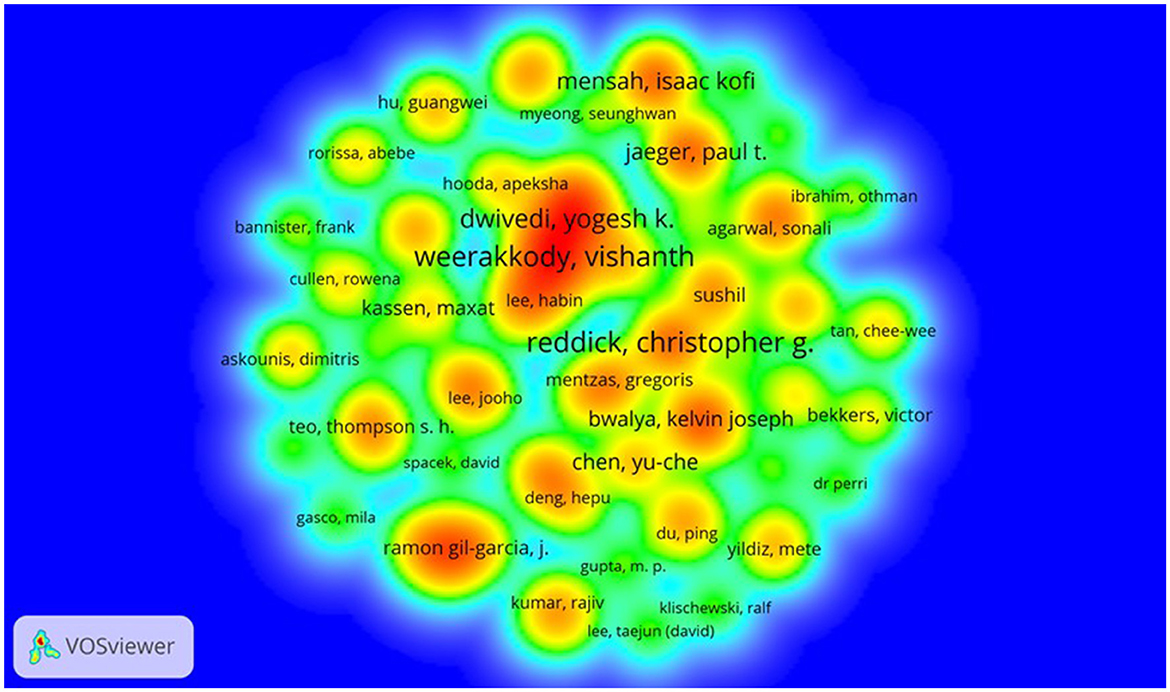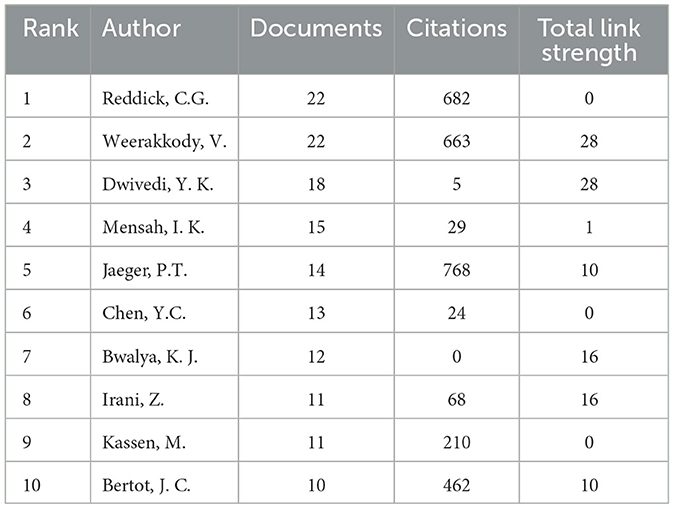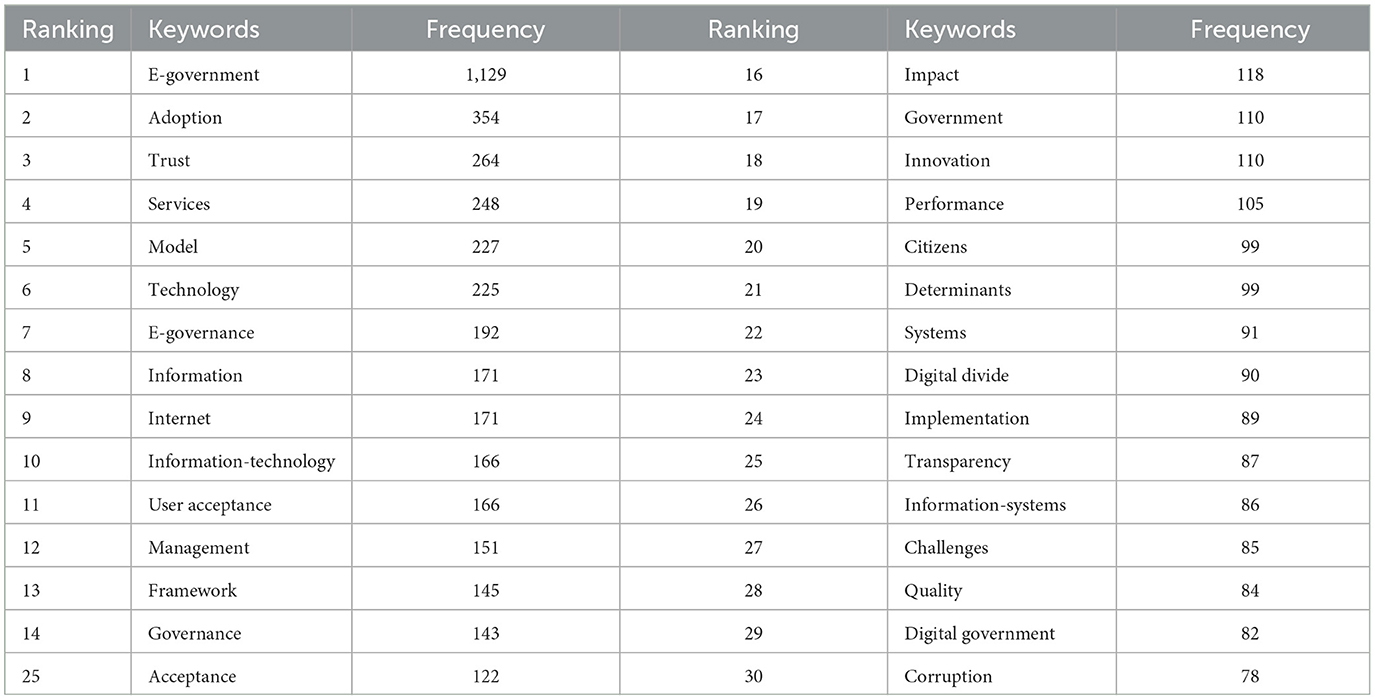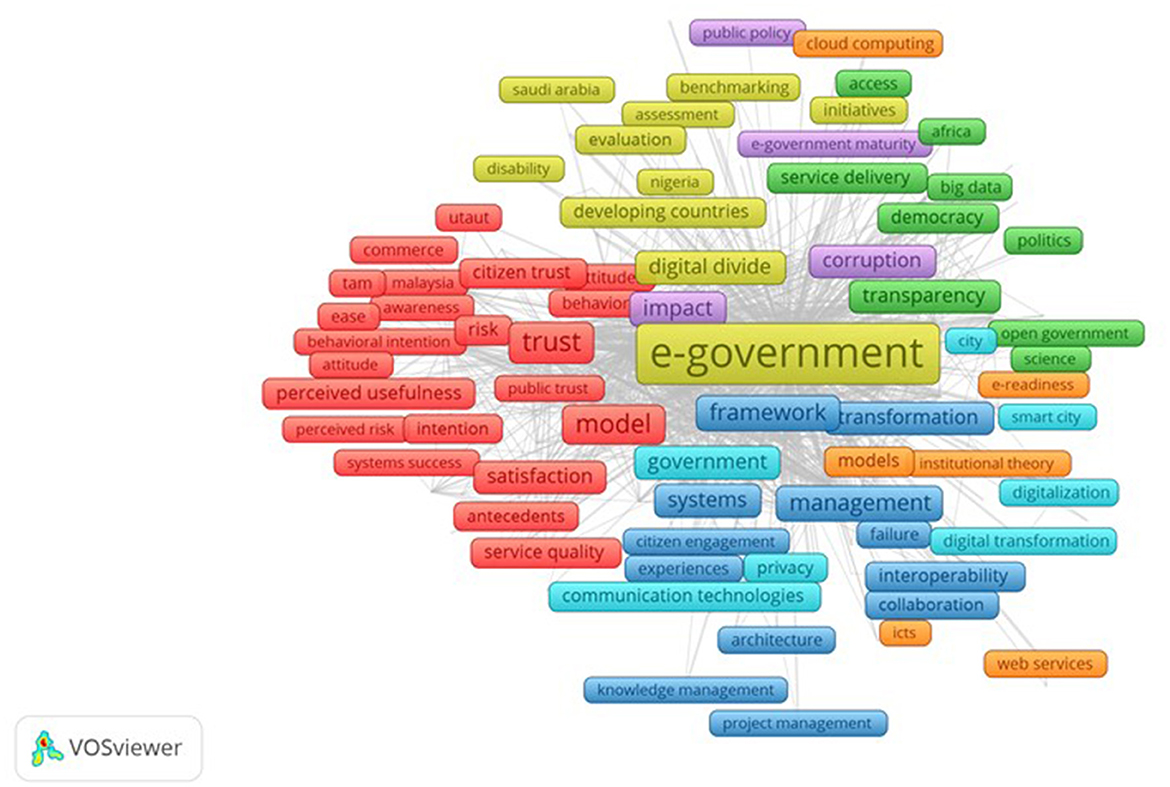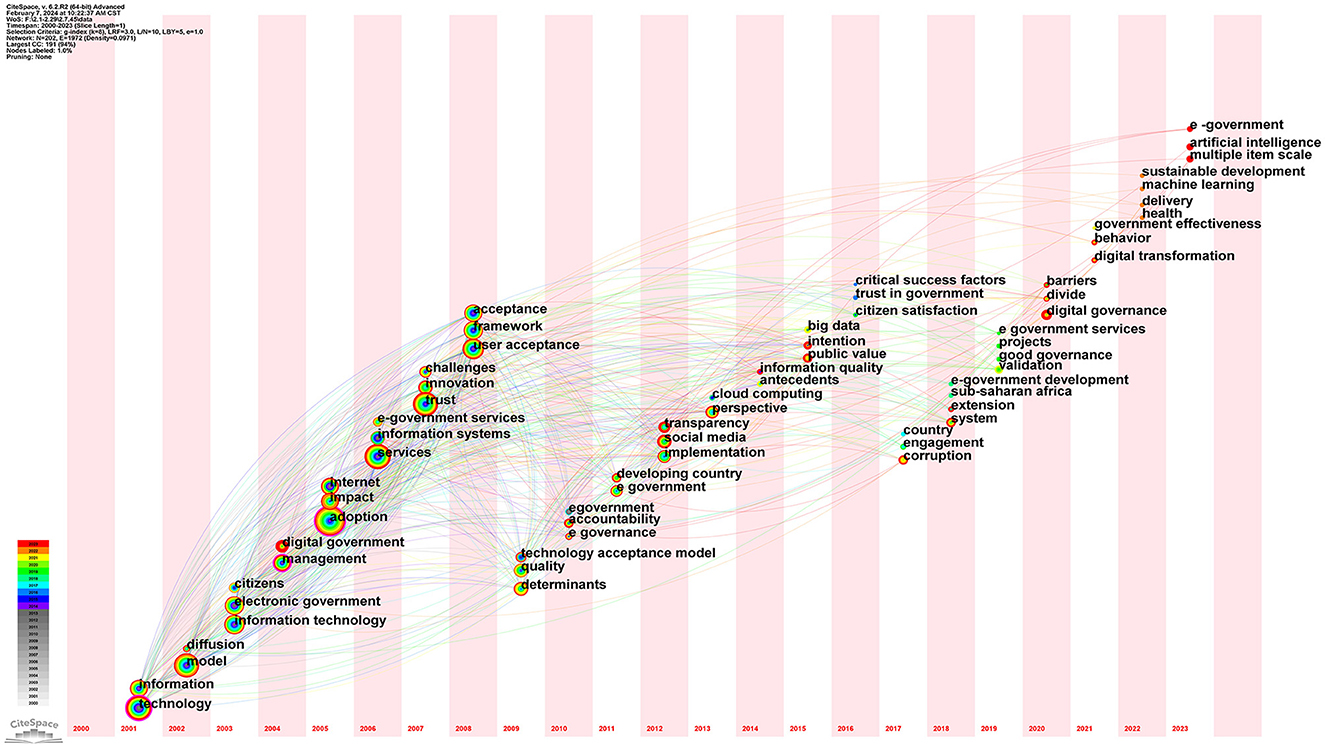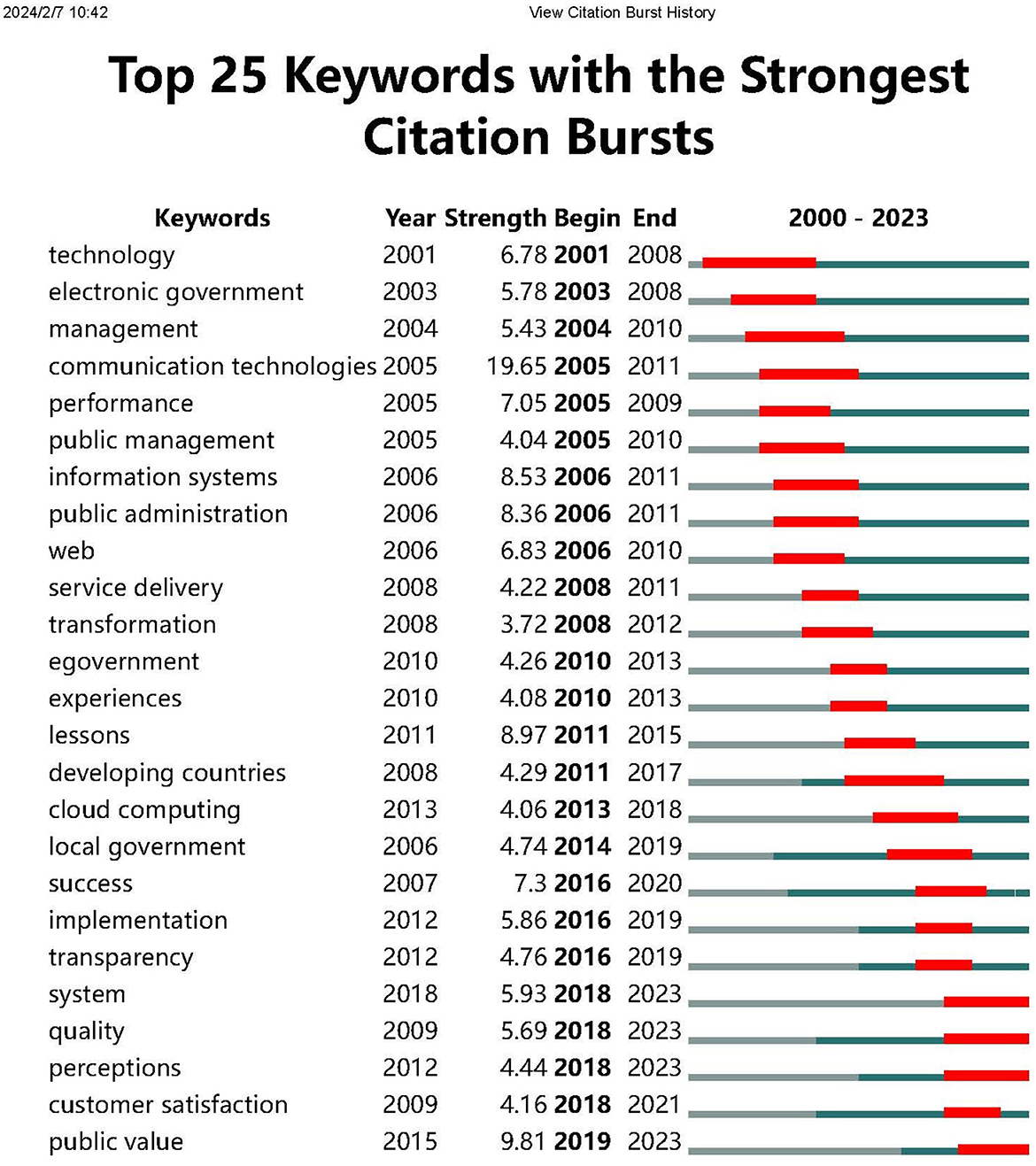- Faculty of Social Sciences and Humanities, Universiti of Kebangsaan Malaysia, Kuala Lumpur, Malaysia
Exploring digital governance is essential for grasping how technology can be employed to enhance public services, boost efficiency, and foster transparency and engagement. This study aims to conduct a systematic review of digital governance research in order to explore its development, emerging research trends, network of leading researchers, countries and institutions that contribute greatly to this field. A bibliometric study was conducted on digital governance works using the following terms: “digital governance,” “E-governance,” “digital government,” and “E-government” as the keywords. VOSviewer and CiteSpace were two tools used for the bibliometric analysis. Results showed that the United States played a dominate role in digital governance studies, followed by China, the United Kingdom, India, and Spain. Brunel University, University at Albany, and University of Johannesburg were the top three research institutes for digital governance. Reddick C.G., Weerakkody V., Dwivedi, Y. K., Mensah, I. K., and Jaeger, P.T. served as the representative researchers in this field. In addition, topics including usability and reliability of digital governance system, quality assurance under the framework of digital governance, the quality of digital service, impact of digital governance on public perception, effects of digital transformation on public value perceptions were the focal points in recent years.
1 Introduction
Just as the term E-Commerce came into existence during the rapid expansion of the Internet, the term E-Government also emerged in response to the technological advancements and increased connectivity facilitated by the Internet boom. The concept of E-Gov (Electronic Government or Electronic Governance) originated in the late 1990's as a platform for practitioners to exchange experiences. This period witnessed the integration of digital technologies into governmental processes, giving rise to the concept of leveraging electronic means for more efficient and accessible government operations.
Various institutions and scholars have provided distinct definitions for E-Government. As articulated by the U.S. Congress in 2002, it refers to the government's strategic use of web- based Internet applications and other information technologies. This, coupled with associated processes, serves the dual purpose of enhancing access to and delivery of government information and services to the public, other agencies, and government entities, while concurrently fostering improvements in government operations—encompassing effectiveness, efficiency, service quality, and overall transformation.
Expanding on this perspective, Grönlund (2010) and Grönlund and Horan (2005) described E-Government as the transformative integration of information technologies by government agencies, which is aimed at revolutionizing interactions with citizens, businesses, and various governmental sectors, thus enhancing the delivery of government services to citizens, improving interactions with businesses, empowering citizens through information access, and building a more efficient process in government management.
Initially, E-Government primarily concentrated on developing citizen-centric services and improving government operations without considering factors outside of the public sector (Janssen and Estevez, 2013). Contemporarily, E-Government research presents a multifaceted exploration of the evolution, implementation, challenges, and future prospects of digital governance. Digital government, originating in the late twentieth century, involves the use of information and communication technologies to enhance the efficiency, accessibility, and quality of public sector operations. The evolution of digital government reflects a shift toward networked, transparent, and user-oriented governance models, influenced by internet-era technological capabilities and changing expectations of citizens and businesses (Dunleavy and Margetts, 2006). Stages of development range from basic information spreading to complex integration and transactional capabilities (Layne and Lee, 2001). Globally, digital government implementation varies due to technological, political, and socio-economic factors. Developed countries lead in rankings, while developing countries make strides with innovative models (Richard, 2002). Comparative studies offer insights and lessons applicable in different contexts (Andersen et al., 2010). In China, a comprehensive digital transformation strategy includes significant investments in digital infrastructure, innovation, and technology-led development. Initiatives like smart cities, digital identity systems, and nationwide e-service platforms demonstrate the government's ambition to enhance state capacity and public service delivery (Ma, 2015; Zheng L., 2017). Despite progress, challenges persist, including the digital divide, privacy concerns, and institutional resistance. Disparities in technology access hinder service effectiveness and equity (Norris, 2001), and privacy and security issues are of paramount importance with government transactions (Bertot et al., 2010). Transforming bureaucratic structures faces resistance, requiring investment in technology, infrastructure, human capital, and policy frameworks (Dawes, 1996; Schöll and Scholl, 2014). The future of digital government will be shaped by ongoing technological innovations and public expectations. Emerging technologies like AI, blockchain, and IoT offer possibilities for personalized, predictive, and participatory government services (Bertot et al., 2010). The emphasis is growing on using digital government to achieve broader societal goals, including sustainability, social inclusion, and economic development (Meijer and Bolívar, 2016). Over time, E-government policies and research have moved away from a predominantly technology-centered approach. Instead, there has been a shift toward seeing citizens as customers and prioritizing the creation of services driven by customer needs and preferences (Janssen and Estevez, 2013).
E-Government pertains specifically to activities within government organizations, with its use in IS (Information Systems) research often limited to those government entities offering services to citizens or companies. In contrast, E-Governance encompasses the entire societal management system. This broader system involves activities not only by government organizations but also by companies, voluntary organizations, and, notably, citizens—a facet often overlooked (Grönlund and Horan, 2005). E-Governance can be defined as the provision of government services and information to the public through electronic methods. Enhanced informational capabilities could greatly improve the interactions between the government and citizens (Christine and John, 1998). Numerous governments and companies hold the belief that technology can replace traditional governance and human accountability (Gil et al., 2019). The utilization of Information Technology (IT) facilitates an efficient, rapid, and transparent process for sharing information with the public and other agencies, as well as for conducting government administrative activities. With digital transformation, governance now encompasses more than just the decision-making rights and responsibilities of the IT department. Technology has become integral to the entire organization and its operations, rather than being merely an organizational unit (Jewer and Van Der Meulen, 2022).
Dunleavy and Margetts (2006) and Meijer et al. (2012), used the term digital governance, defining it as a transformative concept, covering mechanisms, processes, and traditions determining power exercise, stakeholder engagement, and decision-making in the digital age. It presents the impact of rapidly evolving digital technologies over traditional governance structure, where policy- making, regulation, and service delivery are all adapted. Technologies have profound influence on digital governance. Technologies such as blockchain, AI, and big data play a transformative role in reshaping governance expectations, presenting opportunities for transparency and citizen engagement. However, challenges related to privacy and security occurred simultaneously, as noted by Bertot et al. (2010) and Wirtz and Müller (2018). Governments should prioritize improving infrastructure in rural areas and provide free or subsidized access to e-government services, while also implementing digital skills training programs, particularly for older and less educated individuals, to bridge the digital divide (Sharma and Soliman, 2003). Ranging from the digital divide to concerns about data privacy, these obstacles require targeted policies, infrastructure development, and education investments. Ethical considerations emerge as paramount in ensuring public trust and legitimacy in the ongoing efforts toward digital governance, as highlighted by Jaeger and Thompson (2003) and Norris (2001). In addition, Bellamy and Taylor (1998) and Bovens and Zouridis (2002) believed that the establishment of adaptive and responsive governance structures is of great importance, since it is crucial for effectively harnessing the benefits of technology while navigating and mitigating associated risks.
The diverse political, social, and technological dynamics of each country significantly influence the construction of global digital governance. It is evident as leading nations such as Estonia and Scandinavia adopt citizen-centric approaches and innovative digital services, while larger countries like the United States and China concentrate on expanding digital initiatives. These endeavors encounter challenges associated with access and regulatory intricacies, as discussed by Margetts and Dunleavy (2013) and Zheng Y. (2017). In China, digital governance initiatives strategically target transparency, public sector efficiency, and citizen engagement. The most typical one is the “Internet Plus” strategy, where internet-based technologies are integrated, reflecting China's distinctive political and regulatory emphasis on state-led governance, as stated by Zhang and Cheng (2019) and Ma (2015). The future of digital governance is shaped by technological innovations and societal shifts. Networked governance models, citizen-led initiatives, and cross-border collaborations suggest a move toward open, flexible structures (Luna-Reyes and Gil-García, 2014; Meijer and Bolívar, 2016).
E-governance offers critical improvements to the efficiency and effectiveness of governance. It enhances government processes by automating and streamlining internal operations, thereby reducing costs and increasing productivity. E-governance also serves to connect citizens with their government more directly by providing online services and information, which improves the quality and convenience of public services and fosters a more transparent and accountable government. Furthermore, it builds external interactions by strengthening the ties between government and other institutions, including businesses and civil society organizations, which can lead to better policy-making and more responsive governance. By leveraging ICTs, E-governance can empower local communities, support decision-making with timely and accurate data, and contribute to broader societal goals such as sustainable development and social inclusion. E-governance extends beyond the realm of E-government. E-government focuses on delivering government services and information to the public through electronic means. In contrast, E-governance facilitates direct citizen involvement in political activities, surpassing traditional government functions. Kar et al. (2017) highlighted that the transformative impact of digital tools and platforms on citizen engagement, emphasizing their role in fostering participatory governance. By shifting from traditional top-down models to inclusive digital platforms, and through initiatives like e-participation tools, innovative engagement models, and open data, governments can enhance transparency, accountability, and citizen involvement in decision-making processes. It encompasses aspects like e-democracy, e-voting, and online political participation. Governance is influencing governments, prompting consideration of social contracts within a digital governance framework (Idzi and Gomes, 2022). Essentially, E-governance includes government functions, citizen engagement, political parties and organizations, as well as parliamentary and judicial roles (Jayashree and Marthandan, 2010).
Although studies on digital governance are increasing, there is a relative scarcity of systematic reviews, including its development, emerging research trends, leading researchers, and countries and institutions that have made significant contributions to this field. Therefore, this study serves as a supplement to systematic reviews of digital governance. Additionally, through a systematic analysis, this study highlights that digital governance is an interdisciplinary field involving multiple disciplines such as computer technology, public administration, political science, and economics. However, current research may not fully explore the intersections and integrations among these different fields. Furthermore, while digital governance brings many opportunities, it also comes with challenges such as privacy, security, and the digital divide. These challenges require more attention and research.
2 Materials and methods
2.1 Data collection
To ensure the scientific credibility and reliability of the data origin, this scholarly literature is derived from the primary collection of the Web of Science (WOS) database. WOS is recognized as the most extensively utilized and authoritative database for academic publications and citations.
The data were obtained by searching the topic terms “digital governance,” “E-governance,” “E-government,” and “digital government” from 2000 to 2023. The document type specified for retrieval was journal articles. Following the retrieval process and the elimination of duplicated and irrelevant articles, this research ultimately gathered 2,876 published papers within the 24-year timeframe.
2.2 Research method
Bibliometric approaches have been employed for a quantitative examination of written publications, offering valuable insights into the intellectual terrain of particular research domains. This method allows for a systematic literature review, aiding in the extraction of information and recognition of patterns within the scholarly field. Up to now, there are many visualization software tools, with notable attention given to CiteSpace developed by Chen (2006) from Drexel University in the United States and VOSviewer developed by CWTS at Leiden University in the Netherlands. Both tools excel in generating comprehensive visualizations, offering excellent visual effects, and providing research perspectives from different angles (Song and Chi, 2016).
This research utilized VOSviewer for analyzing keywords concurrence, cooperation networks, presenting hotspots, collaborations among researchers, nations and institutions in the field of digital governance. Additionally, CiteSpace, known for its trend depiction and customizable parameters, was employed to visualize keywords time zone and burst detection, through which the focal areas, and prospective trends within the realm of digital governance will be explored. Figure 1 is the technical road map of this study, which generally presents the process of the research including data collection, data screening, the use of analytical tools as well as the specific analytical framework.
3 Discussion
3.1 Literature development trends
Based on statistical analysis obtained from the Web of Science, the total number of publications in the field of digital governance or digital government is 2,876 articles. Figure 2 illustrates the annual publication volume in this field from 2000 to 2023. Overall, it shows an increasing trend, indicating that over the past two decades with the development of information technology, research on digital governance and digital government has gained more attention. Findings suggest that initial interest in this field was rare before 2001, followed by a rapid increase in attention after 2002, with publication volumes surpassing 100 annually since 2007. The highest publication volume was observed in 2012, and although there was a subsequent decline, there has been a steady increase since 2020. To some extent, this is closely related to the impact of the COVID-19 pandemic on government digital governance. The pandemic accelerated the adoption of digital government, prompting governments worldwide to swiftly implement digital solutions to address the challenges posed by the crisis. This indicates that the transformation of government, digital government, and digital governance have been significantly influenced by the combination of public emergencies and the development of digital technologies.
3.2 Cooperation network
3.2.1 Contribution and cooperation on national level
VOSviewer enables researchers to visually represent co-authorship networks on a country level, offering valuable insights into collaborative patterns among nations. This facilitates the identification of both robust and less pronounced connections between countries, providing a holistic comprehension of international cooperation across diverse research domains. In this section, “country” was chosen as the node for research to get the cooperation network among countries in the field of digital governance. A total of 125 countries were involved, where 42 countries came to a threshold of 20 or more publications. As can be seen in Figure 3, the size of the node represents the contribution of each country in this field, of which the biggest is the USA, proving its leading role of the research in this field. Table 1 presents the top ten countries that contribute to digital governance. In addition to USA, the other top countries are China, England, India, Spain, Australia, South Korea, Greece, South Africa and Canada, showing that scholars in these countries also have strong interest in the field of digital governance. The other top countries are China, England, India and Spain, showing that scholars in these four countries also have strong interest in the field of digital governance. As can be seen from the depth and complex connection between countries, the USA has a close relationship with China, South Korea and Mexico, while China as a super power in digital technology, keeps close a cooperation with USA, Pakistan and Malaysia.
For the overlay visualization, there is a bar on the bottom right of Figure 4, with the colors that illustrate the time when each country engaged in the study of digital governance. It is evident that the USA, England, Greece, Canada were the earliest ones. Regarding the top five contributing countries, China and India were the later ones, demonstrating the rapid development of digital technology and implementation of it on governance of the two big countries.
3.2.2 Contribution and cooperation on institutional level
A total of 2,300 research institutions were involved in the digital governance study. Among them, 60 research institutions reached a threshold of 10 or more publications in this field. Based on Figures 5, 6, together with the summary from Table 2, it can be seen that the most influential research institution is Brunel University with a total number of publications of 45, and a total link strength of 16. The next two are the University at Albany and the University of Johannesburg with a total number of publications of 42 and 33, respectively. The map also illustrates that institutional collaboration in digital research exhibits regional characteristics, with key institutions primarily located in countries that contribute greatly in this field including the United States and the United Kingdom. Notably, based on the top five institutions, the University of Johannesburg, South Africa and the National University of Singapore, Singapore, rank third and fifth, albeit in terms of nation contributors, South Africa ranks ninth and Singapore is not listed in the top ten. In addition, as for the second nation contributor, China, Tsinghua University, Huazhong University of Science and Technology and Shanghai Jiaotong University, rank 12, 16, and 19, respectively. As can be seen from the overlay visualization, the institutions from South Africa and China are colored green and yellow, showing that they recently started their interest with digital governance, which to some extent, matches with the overlay visualization of nation cooperation.
3.2.3 Contribution and cooperation on researchers' level
A total of 5,267 researchers were involved in the digital governance study. Among them, 97 different pieces of research reached a threshold of 5 or more publications in this field. Through the analysis of Figure 7 on researchers' contribution, it can be found from the Table 3 that the top five contributors on publication in this field are Reddick C.G., Weerakkody V., Dwivedi, Y. K., Mensah, I. K. and Jaeger, P.T. According to the index of citations, the top five are Jaeger Paul T., Reddick C.G., Weerakkody V., Bertot, J. C., and Kassen, M. Furthermore, it can be seen from the density visualization that there are 46 clusters of author cooperation, of which 14 of them derive from more than three authors in a group. Since the deeper the color is, the more active the author will be in this field. Therefore, it can be seen that Weerakkody V., Dwivedi, Y. K., Reddick C.G., Gil-García, J. R., Mensah, I. K., Joseph, B. K., and Jaeger, P.T. are the most active researchers in this field and maintain close cooperation with other researchers.
3.3 Researching hotspots and emerging trends
3.3.1 Keyword: co-occurrence
Analyzing keywords in VOSviewer is a crucial tool for researchers seeking to comprehend the composition of a research domain, identify emerging patterns, and enhance collaboration with fellow researchers. The VOSviewer software possesses unique advantages in the field of keyword co-occurrence clustering technology. The author utilized VOSviewer software, choosing the fractional counting method, with the total number of keywords at 5,726, a threshold of 20, to create a keyword co-occurrence weighted graph for the study of digital governance (Figure 8). The size of the circle representing a keyword indicates its frequency, with larger circles denoting higher frequencies, signifying more popular topics in the field of digital governance. The placement of keywords toward the center of the graph indicates their greater importance, highlighting them as crucial concepts within the research field. The TOP 30 keywords in digital governance research were organized and ranked, as presented in Table 4.
Figure 8 and Table 4 reveal that keywords such as “E-government,” “adoption,” “trust,” “service,” and “model” hold a central position in the study of digital governance trends. These keywords have a certain representation and have gained high attention within the academic community around the globe. Xanthopoulou et al. (2023) show how digital governance adoption integrates digital technologies and methods into organizational or government operations. Digital adoption enhances internal efficiency, meets regulatory requirements, enables data- driven decision-making, and improves public services, leads to more efficient service delivery and resource utilization for government agencies and businesses, thus making it an important topic for researchers to explore. Establishing digital trust is a crucial element for organizations to facilitate and safeguard their digital transformation. Institutional trust pertains to the confidence that citizens have in government and political institutions, serving as a significant indicator of the vitality of democracy in contemporary nations (Chen et al., 2023). It can be found that digital governance and trust is closely intertwined, with trust being a pivotal element in the acceptance and prosperity of digital initiatives. According to Milakovich (2012), the adoption of digital information and communication technologies (ICTs) to reform governmental structures and public services is widely perceived as an enlightened strategy for the twenty-first century. It is seen as a potential solution to reinvigorate democracy, reduce costs, and enhance the quality of public services. The digital governance models are constantly changing and adapting to leverage the capabilities of emerging technologies, and there are no fixed or definitive models for digital governance. In terms of “model,” numerous digital governance models exist, and they are consistently adapting to leverage the capabilities of emerging technologies. These models are not fixed or limited, and their examination should be contextualized within discussions surrounding the concept of digital governance. Additionally, topics including information technology, user acceptance for digital platforms, management of digital governance, and framework for digital governance, have also become research hotspots in this field.
3.3.2 Keyword: clustering
Figure 9 illustrates a clustering view of keywords in digital governance research, where the same color represents a cluster, indicating a specific theme within digital governance studies. As depicted in Figure 9, digital governance research primarily encompasses seven clustered themes.
3.3.2.1 Cluster 1: E-government adoption and trust
The keywords in this cluster include adoption, trustworthy, service, etc. E-government relies significantly on adoption and trust, as they play a pivotal role in motivating citizens to embrace E-government services. They contribute to diminishing perceived risks, fostering civic engagement, surmounting initial obstacles, and establishing enduring relationships between citizens and the government. According to Papadopoulou et al. (2010), trust is a fundamental component of E-government, and therefore, it should not be considered as an afterthought. Instead, it should be carefully considered early in the process, integrated with the design and deployment of an E-government system. Warkentin et al. (2002) believed that to achieve cost reduction, enhance services, and enhance responsiveness to citizens, it is crucial for both national and local governments to instill trust in the online services they currently offer or plan to offer in the future. Dashti et al. (2010) suggested that feeling trust, distinct from conventional adoption models, centers not only on users' beliefs about the e-service provider but specifically on how the provider perceives them. This will enhance our understanding of user evaluation and the use of E-government while elucidating the reciprocal nature of user interactions with E-government and other e-service providers.
3.3.2.2 Cluster 2: digital governance and citizen participation
The high frequency keywords in this cluster cover digital governance, transparency, citizen participation, etc. In digital governance, citizen participation plays a crucial role by promoting a feeling of shared ownership, collective responsibility, and accountability. It entails involving citizens in public affairs through the utilization of digital tools and platforms like social media, mobile applications, and online digital platforms. Muhlberger (2006) explored citizen involvement in local governance to gauge the adequacy of current information and communication technology (ICT) in meeting community communication and information requirements. Luciano et al. (2018) first identified strategies and barriers for the adoption of digital governance (DGO) in the Brazilian public administration, specifically focusing on strategic objectives related to social participation outlined in the Brazilian Digital Governance Policy (DGP), then proposed three strategic objectives related to social participation, including promoting collaboration in the public policy cycle, expanding and encouraging social participation in enhancing public services, and enhancing direct interaction between the government and society. Rodriguez-Hevía et al. (2020), by reviewing citizen's involvement in E-government of the European Union, proposed that while many citizens have access to the Internet, it does not automatically imply that they will extensively use e- government services. Digital literacy appears to be the most critical factor influencing overall E-government usage. In addition, Matheus et al. (2023) pointed out that transparency is only created when open data is useful to the public. Functionality can enhance transparency, thereby increasing perceived efficiency and perceived usefulness. Special attention should be paid to the diverse needs of citizens and ensuring efficiency, as the time of citizens and other users is limited. Transparency can enhance the credibility of open government, but usefulness may not always necessitate transparency, therefore it is suggested to create classifications for transparency initiatives.
3.3.2.3 Cluster 3: digital governance framework and digital transformation
The high frequency keywords in this cluster include digital transformation, framework, management, innovation, etc. Digital governance provides a strategic framework for developing and enacting innovative approaches to transition from bureaucracy-oriented to citizen-focused public services (Milakovich, 2014). Al-Badi et al. (2018) proposed that a comprehensive framework for Big Data governance is essential for establishing guidelines, procedures, and criteria to efficiently manage and safeguard the availability, usability, integrity, consistency, auditability, and security of Big Data. Jia and Chen (2022) expanded the “issue-actor-mechanism (IAM)” model into an analytical framework for delineating global digital governance. Tannou et al. (2012) suggested that governance plays a pivotal role in the success of digital transformation, ensuring that digital initiatives are coordinated and shared appropriately within the company, aligning with its structure, culture, and strategic objectives. Gil-Garcia et al. (2018) addressed that the scholarly communities of Digital Governance (DG) and Public Management (PM) exhibit variations across multiple dimensions while also sharing significant similarities. Importantly, there is evidence of potential for collaborative efforts that could benefit both fields of study.
3.3.2.4 Cluster 4: digital divide
The high frequency keywords in this cluster include digital divide, e- government implementation, developing countries, etc. The digital divide significantly affects digital governance, leading to adverse outcomes for individuals in underdeveloped regions and those with lower socio-economic status. Limited access to digital technologies and the Internet can create obstacles in utilizing E-government services, resulting in disparities in resource access and public service utilization. Yigitcanlar and Baum (2008) indicate that the term “global divide” signifies the gap in Internet accessibility between advanced and developing nations, while the “social divide” pertains to the disparity in information access within individual countries, separating the affluent from the disadvantaged. Mariscal (2005), Ogunsola and Okusaga (2006), and Acilar (2011), analyzed the situation of digital divide in developing countries by reviewing the facts in Mexico, African countries, and Turkey.
3.3.2.5 Cluster 5: digital governance and sustainability
The high frequency keywords in this cluster cover sustainability, corruption, sustainable development, public policy, etc. Barbosa (2017) pointed out that digital transformation serves as a tool to promote sustainable development and more inclusive societies. From a practical standpoint, digitization presents the opportunity to enhance governmental operations and, if properly orchestrated, can play a role in advancing the imperative sustainable development agenda in the foreseeable future. Xu et al. (2022) believed that the bolstering of digitization contributes to sustainable development, as evidenced by the broad array of literature and theoretical frameworks. The belief that notable advancements in digital governance inevitably result in improved sustainable governance is erroneous. The dynamics between digital governance and sustainable governance are complex, involving various potential moderating and mediating factors that warrant additional investigation (Durkiewicz and Janowski, 2021). In terms of corruption and digital governance, Martins et al. (2018) highlighted a significant finding: the correlation between digital government and corruption differs among income groups, suggesting that policymakers in the least developed nations should not view E-government as a definitive remedy for combating corruption.
3.3.2.6 Cluster 6: smart city and information security
The high frequency keywords in this cluster cover smart city, information security, privacy, etc. According to Sucupira Furtado et al. (2023), the connection between smart cities and digital governance is substantial, as digital governance serves as a fundamental element of the smart city initiative and a crucial avenue for realizing sustainable development objectives through digital transformation. Smart city governance has evolved from the wider realm of E-governance and seeks to improve the effectiveness of public institutions by leveraging digital technologies and institutional innovation (Myeong and Bokhari, 2023). By reviewing the situation of smart city in Belgium, Esposito et al. (2023) provided fresh insights into the multifaceted nature of the smart city concept, revealing that local authorities can flexibly employ smart city initiatives as tools to address various location-specific environmental, social, and economic challenges. Singh and Karaulia (2011) suggested that information security is crucial in E-governance initiatives, ensuring the confidentiality of transactions and data, protecting government documents from unauthorized access, and integrating robust security systems to ensure successful project implementation. In digital governance, safeguarding information security and integrity is paramount, as any security loopholes may result in severe repercussions, undermining public trust and government credibility, necessitating comprehensive measures spanning policy, processes, and training for successful implementation.
3.3.2.7 Cluster 7: public administration under digital governance
The high frequency keywords in this cluster cover public administration, infrastructure, efficiency, etc. Digital governance provides a framework and approach to leveraging digital technologies to enhance the efficiency and transparency of public administration while promoting the development and maintenance of public infrastructure. Margetts (2008) explored the relationship between E-government and public management reform, suggesting that “digital-era governance” (DEG), which challenges or transcends the managerial styles of New Public Management (NPM), is a valuable approach to understanding contemporary administrative reform, outlining three main themes of DEG: reintegration, needs-based holism, and digitization, illustrating how the widespread use of digital technologies by governments, businesses, and society at large triggers organizational responses in government entities. As public administrations are still in the process of transitioning to E-government and/or E-governance perspectives and have not fully undergone digital transformation, the empirical data were collected from administrations at various stages of this process (Mergel et al., 2019). According to Chantillon (2021), as suggested by the concept of “good enough governance,” public administrations are indeed continuously balancing the public values they strive to achieve, the use of coordination tools, and the interrelated objectives set by different public management departments. To facilitate digital transformation, changes in how public administrations function and the public values they strive for will be necessary. However, these changes will only occur gradually and sometimes may not lead to the desired success, thus necessitating monitoring and evaluation.
3.3.3 Evolution of research hotspots
The time zone analysis of CiteSpace represents the chronological evolution of scholarly literature and pinpoints emerging trends and patterns over time. By organizing articles and terms based on their publication dates, CiteSpace's time zone view enables researchers to examine the fluctuation of research topics, notable terms, and significant advancements within a specific field. This functionality is particularly beneficial for monitoring the advancement of scientific knowledge, recognizing influential publications, and comprehending the temporal context of research trends. The time zone view offers researchers a distinctive viewpoint to glean insights into the historical progression of a discipline and choose informed assessments regarding the significance and impact of scientific endeavors throughout time.
From Figure 10, it can be observed that research in the field of digital governance in the core collection of the foreign Web of Science database can be divided into three phases, with the earliest research traced back to 2001. Specifically, from 2001 to 2008, scholars primarily focused on information technology, which is the prerequisite of digital governance or digital government, then shifted their attention on the adoption, acceptance, and management of digital governance. From 2009 to 2018, there was a notable emphasis on quality, transparency, trust and satisfaction with digital governance. It is found that the less attention has been put on the technical level but more on the effects and feedback of digital governance. Finally, from 2019 to 2023, scholars predominantly investigated corruption, digital divide, artificial intelligence, and sustainable development in digital governance. According to these keywords, it can be summarized that during this phase more specific points and long-term goals in a wider scale have become the interest of researchers. As mentioned in previous sections in this article, digital divide's impact over developing countries, whether digital governance advances sustainable development, artificial intelligence's impact over digital governance, plays a role.
3.3.4 Research frontiers in the field of digital governance
Burst detection in CiteSpace is a functionality designed to pinpoint spikes in activity, such as sudden surges in citations to a specific publication or rapid escalations in the output of publications by a particular author. Utilizing Kleinberg's algorithm, this feature can detect bursts that span multiple years or occur within a single year. The visual representation of burst detection can be applied across different types of nodes, including articles, authors, or keywords, aiding in the identification of highly active research areas or emerging trends (Chen, 2014).
From the Figure 11, it can be observed that the word “technology” has the longest burst period from 2001 to 2008, while communication technologies owns the strongest burst with the strength of 19.65, showing that at the beginning stages of digital governance most of the attention was given on technical level, which complies with the result of time zone analysis in the previous part. As for the latest burst, it can be found that there are four words, “system”, “quality”, “perceptions” and “public value”. According to these words, it can be uncovered that the research frontiers for digital governance include the usability and reliability of digital governance system, quality assurance under the framework of digital governance, the quality of digital service, impact of digital governance on public perception, effects of digital transformation on public value perceptions, etc.
4 Conclusion
(1) The bibliometric analysis of academic literature demonstrates that since 2000, there has been a growing focus in research areas such as digital government, digital governance, digital transformation, and sustainable governance. Examination of the distribution and growth of these topics suggests that research in digital governance is characterized by its interdisciplinary nature, intersecting with disciplines such as computer technology, public administration, political science, and economics. Otherwise, the widespread adoption of digital government has been hastened by global public crises, prompting governments worldwide to swiftly implement digital solutions to tackle crisis-related challenges. This underscores the significant impact of public emergencies alongside the evolution of digital technologies on government transformation, digital governance, and digital government.
(2) At the national level, the United States holds a leading position in the field of digital governance research. The other four countries of China, the United Kingdom, India, and Spain, have also made great contribution in digital governance research. The density of collaboration between countries indicates close relationships between the United States and China, South Korea, and Mexico, while China, as a superpower in digital technology, maintains close cooperation with the United States, Pakistan, and Malaysia. Additionally, the United States, the United Kingdom, Greece, and Canada were among the earliest countries to initiate research related to digital governance. Among the top five contributing countries, although China and India started later, the rapid development of digital technology in these two major countries has swiftly propelled them to the forefront of research in this field.
(3) In terms of institution contributions, the most influential research institutions are Brunel University, the University at Albany, and the University of Johannesburg. Institutional collaboration exhibits regional characteristics, with key institutions primarily located in countries that have made significant contributions in this field, including the United States and the United Kingdom. Among the top five institutions, the University of Johannesburg, South Africa, and the National University of Singapore, Singapore, rank third and fifth respectively, despite South Africa ranking ninth and Singapore not listed in the top 10 in terms of national contributions. This indicates that institutional contributions do not completely overlap with national contributions. From the overlay visualization, it can be seen that the institutions from South Africa and China have made significant contributions to digital governance research in recent years.
(4) In terms of author contributions, the top five contributors in this field are Reddick C.G., Weerakkody V., Dwivedi, Y. K., Mensah, I. K., and Jaeger, P.T. Additionally, Weerakkody V., Dwivedi, Y. K., Reddick C.G., Gil-García, J. R., Mensah, I. K., Joseph, B. K., and Jaeger, P.T., are the most active researchers in this field, maintaining close collaboration with other researchers.
(5) According to the analysis of keywords co-occurrence, clustering, burst and time zone distribution, shows that the current research hotspots and trends in digital governance encompass various aspects. Initially, in the early stages, research primarily focused on the technological level, particularly the application of information technology, as a prerequisite for digital governance or digital government. Subsequently, the focus gradually shifted toward the adoption, acceptance, and management of digital governance, emphasizing the importance of quality, transparency, trustworthiness, and satisfaction. The latest research now increasingly addresses the usability and reliability of digital governance systems, the quality of digital services, the impact of digital governance on public perceptions, and the effects of digital transformation on public values. Additionally, researchers have started to pay attention to some challenges and issues in digital governance, such as corruption, the digital divide, artificial intelligence, and sustainable development. This indicates that digital governance research is gradually expanding from the technological level to broader social and political domains, with a greater focus on the impacts and practices of digital governance, as well as how to address the challenges and opportunities of the digital age. However, this study also has some limitations. The research data solely comes from the Web of Science database, overlooking literature from other databases such as Elsevier Science and Google Scholar, which may introduce some information bias. The overall coverage of the WoS database is less extensive compared to some other databases such as Scopus, especially in the fields of social sciences and humanities. Other than that, in the humanities, Scopus covers a significant portion of the data available in WoS, whereas WoS only covers a smaller portion of the data available in Scopus. Additionally, due to subscription terms, the accessible timeframe for citations in WoS is relatively short (Pranckute, 2021). Therefore, the study may be limited by the availability of data sources. This implies that it may not comprehensively capture all relevant academic discussions and research findings within the field of digital governance, particularly those published in related disciplinary domains. In the process of literature screening, the diversity in keyword selection may lead to the appearance of semantically similar terms, affecting the accuracy of data analysis. Additionally, only English articles were selected, resulting in some data gaps. Furthermore, the study covers relatively a large time span, constrained by sample selection and the knowledge level of the authors, which may lead to insufficient depth and comprehensiveness in certain parts of the analysis.
Finally, according to previous analysis on research hotspots as well as the evolution of the research of digital governance, it can be assumed that future research on digital governance will focus on the usability and reliability of systems, exploring user acceptance, system performance, and service quality. Additionally, studies will examine how digital governance affects public perception and trust in government services, as well as the impact of digital transformation on public expectations and values. Other than that, challenges and issues in digital governance, such as corruption, the digital divide, artificial intelligence, and sustainable development will continue to be the focus of researchers. What's more, key areas of future research will also include how emerging technologies enhance the personalization and participatory nature of government services, and how to construct a global digital governance framework.
Author contributions
ZL: Conceptualization, Data curation, Formal analysis, Funding acquisition, Investigation, Methodology, Project administration, Resources, Software, Supervision, Validation, Visualization, Writing – original draft, Writing – review & editing. MY: Supervision, Writing – review & editing.
Funding
The author(s) declare that no financial support was received for the research, authorship, and/or publication of this article.
Acknowledgments
Thanks to UKM for the support of this research. We also would like to extend special thanks to the editor and the reviewers for their insightful comments and constructive suggestions.
Conflict of interest
The authors declare that the research was conducted in the absence of any commercial or financial relationships that could be construed as a potential conflict of interest.
Publisher's note
All claims expressed in this article are solely those of the authors and do not necessarily represent those of their affiliated organizations, or those of the publisher, the editors and the reviewers. Any product that may be evaluated in this article, or claim that may be made by its manufacturer, is not guaranteed or endorsed by the publisher.
References
Acilar, A. (2011). Exploring the aspects of digital divide in a developing country. Iss. Inform. Sci. Inform. Technol. 8, 231–244. doi: 10.28945/1415
Al-Badi, A., Tarhini, A., and Khan, A. I. (2018). Exploring big data governance frameworks. Proc. Comput. Sci. 141, 271–277. doi: 10.1016/j.procs.2018.10.181
Andersen, K. N., Henriksen, H. Z., Medaglia, R., Danziger, J. N., Sannarnes, M. K., and Enemærke, M. (2010). Fads and facts of e-government: a review of impacts of e-government (2003–2009). Int. J. Publ. Admin. 33, 564–579. doi: 10.1080/01900692.2010.517724
Barbosa, L. S. (2017). “Digital governance for sustainable development,” in Digital Nations-Smart Cities, Innovation, and Sustainability: 16th IFIP WG 6.11 Conference on e-Business, e-Services, and e-Society, I3E 2017, Delhi, India, November 21-23. 2017, Proceedings 16 (Cham: Springer International Publishing), 85–93.
Bellamy, C., and Taylor, J. A. (1998). Understanding government. direct. Inform. Infrastruct. Pol. 6, 1–16.
Bertot, J. C., Jaeger, P. T., and Grimes, J. M. (2010). Using icts to create a culture of transparency: e-government and social media as openness and anti-corruption tools for societies. Govern. Inform. Quart. 27, 264–271. doi: 10.1016/j.giq.2010.03.001
Bovens, M., and Zouridis, S. (2002). From street-level to system-level bureaucracies: how information and communication technology is transforming administrative discretion and constitutional control. Publ. Admin. Rev. 62, 174–184. doi: 10.1111/0033-3352.00168
Chantillon, M. (2021). A Governance Framework Facilitating a Digital Transformation of the Public Administration. Leuven: KU Leuven.
Chen, C. (2006). CiteSpace II: detecting and visualizing emerging trends and transient patterns in scientific literature. J. Am. Soc. Inform. Sci. Technol. 57, 359–377. doi: 10.1002/asi.20317
Chen, X., Xing, L., Wang, K., and Lu, J. (2023). How does digital governance affect the level of domestic waste separation for rural residents? Empirical evidence from rural areas in Jiangsu Province, China. Front. Publ. Health 11:22705. doi: 10.3389/fpubh.2023.1122705
Christine, B., and John, T. (1998). Governing in the information age. N. Technol. Hum. Serv. 1998:54.
Dashti, A., Benbasat, I., and Burton-Jones, A. (2010). Trust, Felt Trust, and E-Government Adoption: A Theoretical Perspective, AIS Electronic Library (AISeL). Available at: https://aisel.aisnet.org/sprouts_all/375/ (accessed January 15, 2024).
Dawes, S. S. (1996). Interagency information sharing: expected benefits, manageable risks. J. Pol. Anal. Manag. 15, 377–394. doi: 10.1002/(SICI)1520-6688(199622)15:3<377::AID-PAM3>3.0.CO;2-F
Dunleavy, P., and Margetts, H. (2006). Digital Era Governance: IT Corporations, the State, and E-government. Oxford: Oxford University Press.
Durkiewicz, J., and Janowski, T. (2021). Is digital government advancing sustainable governance? A study of OECD/EU countries. Sustainability 13:13603. doi: 10.3390/su132413603
Esposito, G., Terlizzi, A., Guarino, M., and Crutzen, N. (2023). Interpreting Digital Governance at the municipal level: evidence from Smart City Projects in Belgium. Int. Rev. Admin. Sci. 2023:2085232311675. doi: 10.1177/00208523231167538
Gil, O., María, E., Cortés-Cediel, A, and Cantador, I. (2019). Citizen participation and the rise of digital media platforms in smart governance and smart cities. Int. J. E-Plan. Res. 8, 19–34. doi: 10.4018/IJEPR.2019010102
Gil-Garcia, J. R., Dawes, S. S., and Pardo, T. A. (2018). Digital government and public management research: finding the crossroads. Publ. Manag. Rev. 20, 633–646. doi: 10.1080/14719037.2017.1327181
Grönlund, Å. (2010). “Ten years of e-government: the “end of history” and new beginning,” in Electronic Government. EGOV 2010. Lecture Notes in Computer Science, vol. 6228, eds. M. A. Wimmer, J. L. Chappelet, M. Janssen, and H. J. Scholl (Berlin; Heidelberg: Springer), 2.
Grönlund, Å., and Horan, T. (2005). Introducing e-gov: history, definitions, and issues. Commun. Assoc. Inform. Syst. 15:1539. doi: 10.17705/1CAIS.01539
Idzi, F. M., and Gomes, R. C. (2022). Digital governance: government strategies that impact public services. GPPG 2, 427–452. doi: 10.1007/s43508-022-00055-w
Jaeger, P. T., and Thompson, K. M. (2003). E-government around the world: lessons, challenges, and future directions. Govern. Inform. Quart. 20, 389–394. doi: 10.1016/j.giq.2003.08.001
Janssen, M., and Estevez, E. (2013). Lean government and platform-based governance-doing more with less. Govern. Inform. Quart. 30, S1–S8. doi: 10.1016/j.giq.2012.11.003
Jayashree, S., and Marthandan, G. (2010). Government to E-government to E-society. J. Appli. Sci. 10, 2205–2210.
Jewer, J., and Van Der Meulen, N. P. (2022). “Governance of digital transformation: a review of the literature,” in Proceedings of the Annual Hawaii International Conference on System Sciences (Hawaii).
Jia, K., and Chen, S. (2022). Global digital governance: paradigm shift and an analytical framework. Glob. Publ. Pol. Govern. 2, 283–305. doi: 10.1007/s43508-022-00047-w
Kar, A. K., Ilavarasan, P. V., Gupta, M. P., Dwivedi, Y. K., Mäntymäki, M., Janssen, M., (eds.). . (2017). “Digital Nations-Smart Cities, Innovation, and Sustainability,” in 16th IFIP WG 6.11 Conference on e-Business, e-Services, and e-Society, I3E 2017, Proceedings (Vol. 10595), (Delhi: Springer).
Layne, K., and Lee, J. (2001). Developing fully functional E-government: a four stage model. Govern. Inform. Quart. 18, 122–136. doi: 10.1016/S0740-624X(01)00066-1
Luciano, E. M., Wiedenhöft, G. C., and Santos, F. P. D. (2018). “Promoting social participation through digital governance: identifying barriers in the Brazilian Public Administration,” in Proceedings of the 19th Annual International Conference on Digital Government Research: Governance in the Data Age (Delft), 1–9.
Luna-Reyes, L. F., and Gil-García, J. R. (2014). Digital government transformation and internet portals: the co-evolution of technology, organizations, and institutions. Govern. Inform. Quart. 31, 545–555. doi: 10.1016/j.giq.2014.08.001
Ma, L. (2015). “China's E-government development and the future trend,” in Proceedings of the International Conference on E-Business and E-Government. Beijing: IEEE.
Margetts, H. (2008). Public management change and e-government: the emergence of digital-era governance. Routledge eBooks 16, 130–146. doi: 10.4324/9780203962541-16
Margetts, H., and Dunleavy, P. (2013). The second wave of digital-era governance: a quasi-paradigm for government on the Web. Philos. Trans. Royal Soc. A 371:20120382. doi: 10.1098/rsta.2012.0382
Mariscal, J. (2005). Digital divide in a developing country. Telecommun. Pol. 29, 409–428. doi: 10.1016/j.telpol.2005.03.004
Martins, J., Fernandes, B., Rohman, I., and Veiga, L. (2018). “The war on corruption: the role of electronic government,” in Lecture Notes in Computer Science, 98–109.
Matheus, R., Faber, R., Ismagilova, E., and Janssen, M. (2023). Digital transparency and the usefulness for open government. Int. J. Inform. Manag. 73:102690. doi: 10.1016/j.ijinfomgt.2023.102690
Meijer, A., and Bolívar, M. P. R. (2016). Governing the smart city: a review of the literature on smart urban governance. Int. Rev. Admin. Sci. 82, 392–408. doi: 10.1177/0020852314564308
Meijer, A. J., Koops, B. J., Pieterson, W. J., Overman, S., and ten Tije, S. (2012). Government 2.0: key challenges to its realization. Electr. J. E-Govern. 10, 59–69.
Mergel, I., Edelmann, N., and Haug, N. (2019). Defining digital transformation: results from expert interviews. Govern. Inform. Quart. 36:101385. doi: 10.1016/j.giq.2019.06.002
Milakovich, M. E. (2012). Digital Governance: New Technologies for Improving Public Service and Participation. Available at: http://ci.nii.ac.jp/ncid/BB08658986 (accessed January 16, 2024).
Milakovich, M. E. (2014). “Digital governance and collaborative strategies for improving service quality,” in International Conference on Knowledge Management and Information Sharing, Vol. 2 (Setúbal: SCITEPRESS), 109–118.
Muhlberger, P. (2006). “Should e-government design for citizen participation? Stealth democracy and deliberation,” in Proceedings of the 2006 International Conference on Digital Government Research (California, MA), 53–61.
Myeong, S., and Bokhari, S. A. A. (2023). Building participative E-Governance in smart cities: moderating role of institutional and technological innovation. Sustainability 15:15075. doi: 10.3390/su152015075
Norris, P. (2001). Digital divide: civic engagement, information poverty, and the Internet worldwide. Choice Rev. Onl. 40, 40–1165. doi: 10.5860/CHOICE.40-1165
Ogunsola, L. A., and Okusaga, T. O. (2006). Digital divide between developed and less-developed countries: the way forward. J. Soc. Sci. 13, 137–146. doi: 10.1080/09718923.2006.11892542
Papadopoulou, P., Nikolaidou, M., and Martakos, D. (2010). “What is trust in e-government? A proposed typology,” in 2010 43rd Hawaii International Conference on System Sciences (Hawaii: IEEE), 1–10.
Pranckute, R. (2021). Web of Science (WoS) and Scopus: the titans of bibliographic information in today's academic world. Publications 9:12. doi: 10.3390/publications9010012
Richard, H. (2002). Information systems and developing countries: failure, success, and local improvisations. Inform. Soc. 18, 101–112. doi: 10.1080/01972240290075039
Rodriguez-Hevía, L. F., Navío-Marco, J., and Ruiz-Gómez, L. M. (2020). Citizens' involvement in e-government in the European Union: the rising importance of the digital skills. Sustainability 12:6807. doi: 10.3390/su12176807
Schöll, H., and Scholl, M. (2014). “Smart Governance: a roadmap for research and practice,” in iConference 2014 Proceedings (Berlin).
Sharma, S. K., and Soliman, K. (2003). “Digital divide and e-government implementation,” in The Fourth Annual Global Information Technology Management World Conference.
Singh, S., and Karaulia, D. S. (2011). “E-governance: information security issues,” in Proceedings of the International Conference on Computer Science and Information Technology (Pattaya), 120–124.
Song, X., and Chi, P. (2016). A comparative study of VOSviewer and Citespace applications. Inform. Sci. 34, 108–112.
Sucupira Furtado, L., da Silva, T. L. C., Ferreira, M. G. F., de Macedo, J. A. F., and Moreira, J. K. (2023). A framework for Digital Transformation towards smart governance: using big data tools to target sdgs in Ceará, Brazil. J. Urban Manag. 12, 74–87. doi: 10.1016/j.jum.2023.01.003
Tannou, M., Westerman, G., Bonnet, D., and Ferraris, P. (2012). Governance: a central component of successful digital transformation. Digit. Transform. Rev. 3, 14–21.
Warkentin, M., Gefen, D., Pavlou, P. A., and Rose, G. M. (2002). Encouraging citizen adoption of e-Government by building trust. Electr. Markets 12, 157–162. doi: 10.1080/101967802320245929
Wirtz, B. W., and Müller, W. (2018). An integrated artificial intelligence framework for public management. Publ. Manag. Rev. 21, 1076–1100. doi: 10.1080/14719037.2018.1549268
Xanthopoulou, P., Antoniadis, I., and Avlogiaris, G. (2023). Unveiling the drivers of digital governance adoption in public administration. Probl. Perspect. Manag. 21, 454–467. doi: 10.21511/ppm.21(4).2023.35
Xu, J., She, S., and Li, W. (2022). Role of digitalization in environment, social and governance, and sustainability: review-based study for implications. Front. Psychol. 13:961057. doi: 10.3389/fpsyg.2022.961057
Yigitcanlar, T., and Baum, S. (2008). “E-government and the digital divide,” in Electronic Government: Concepts, Methodologies, Tools, and Applications, ed. A. Anttiroiko (Hershey, PA: IGI Global), 1718–1725.
Zhang, X., and Cheng, X. (2019). The roadmap of digital China: explaining the “China Model” of digital governance. Glob. Media China 4, 220–235.
Keywords: digital governance, bibliometric, developmental trends, research hotspots, VOSviewer, CiteSpace
Citation: Lin Z and Yaakop MR (2024) Research on digital governance based on Web of Science—a bibliometric analysis. Front. Polit. Sci. 6:1403404. doi: 10.3389/fpos.2024.1403404
Received: 25 April 2024; Accepted: 24 July 2024;
Published: 16 August 2024.
Edited by:
Ingrid Leijten, Tilburg University, NetherlandsReviewed by:
Ahmad Sururi, Sultan Ageng Tirtayasa University, IndonesiaTimothy Tamutana Tamunang, Zhengzhou Normal University, China
Thomas Ramsey, China Three Gorges University, China
Copyright © 2024 Lin and Yaakop. This is an open-access article distributed under the terms of the Creative Commons Attribution License (CC BY). The use, distribution or reproduction in other forums is permitted, provided the original author(s) and the copyright owner(s) are credited and that the original publication in this journal is cited, in accordance with accepted academic practice. No use, distribution or reproduction is permitted which does not comply with these terms.
*Correspondence: Zhao Lin, UDExODMzM0BzaXN3YS51a20uZWR1Lm15
 Zhao Lin
Zhao Lin Mohd Rizal Yaakop
Mohd Rizal Yaakop